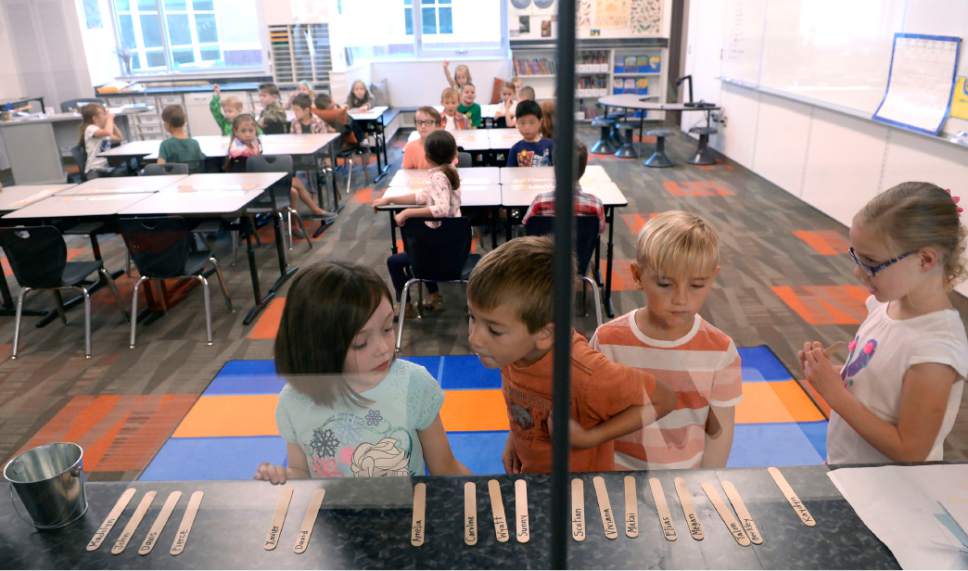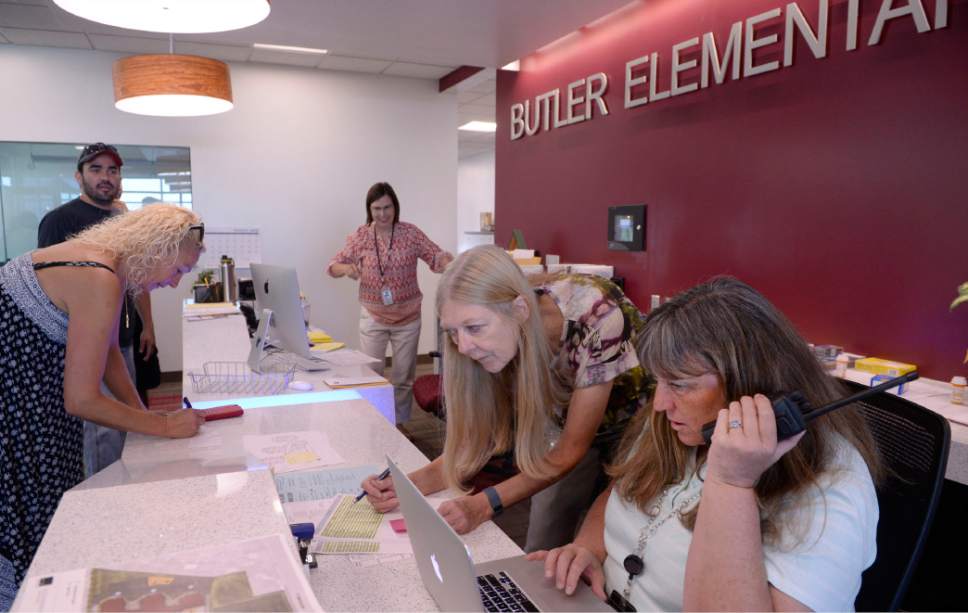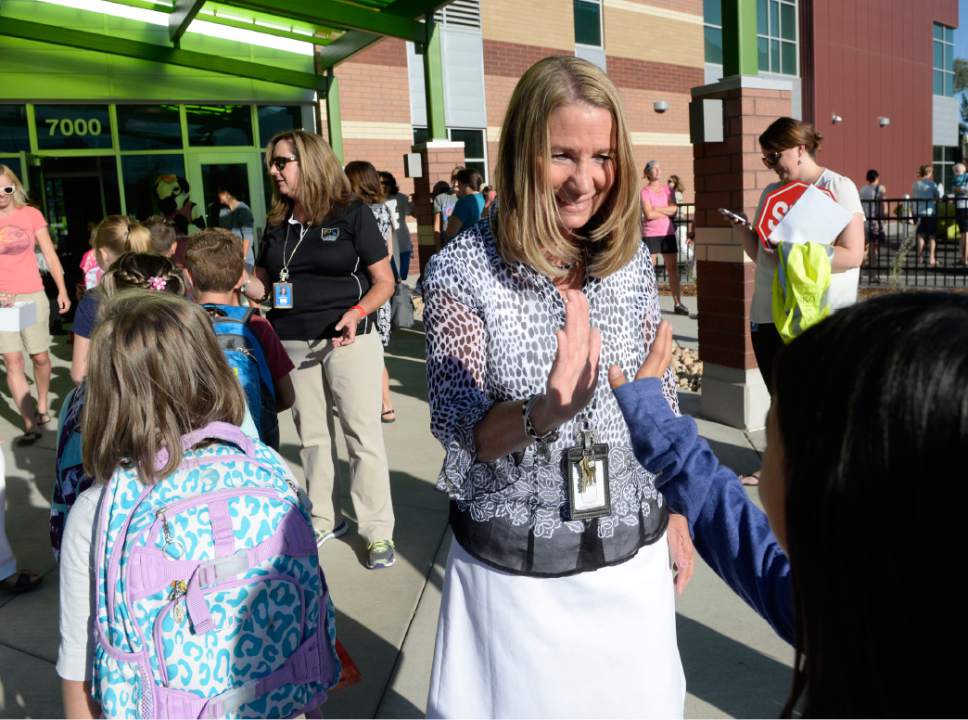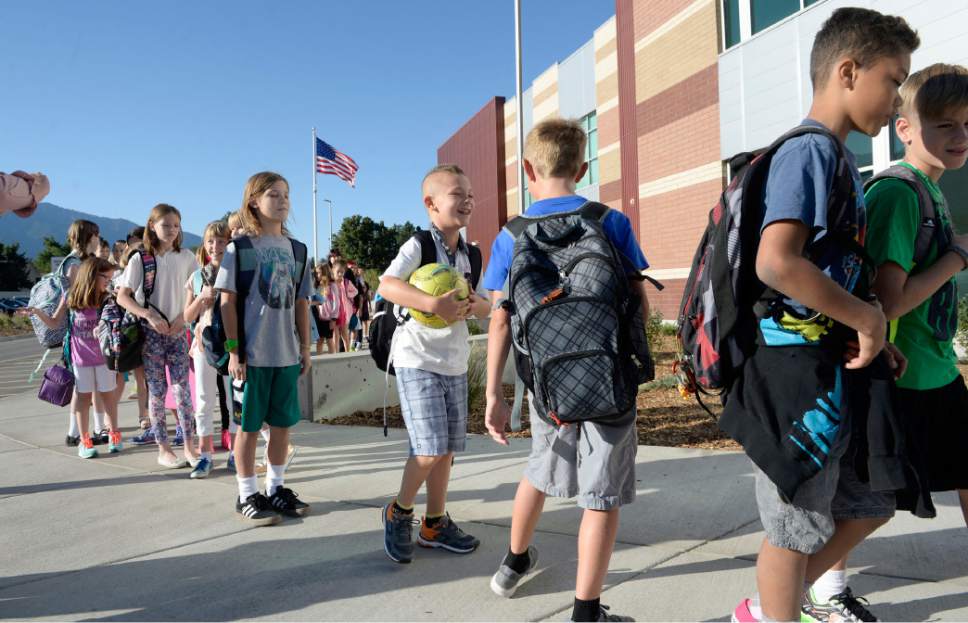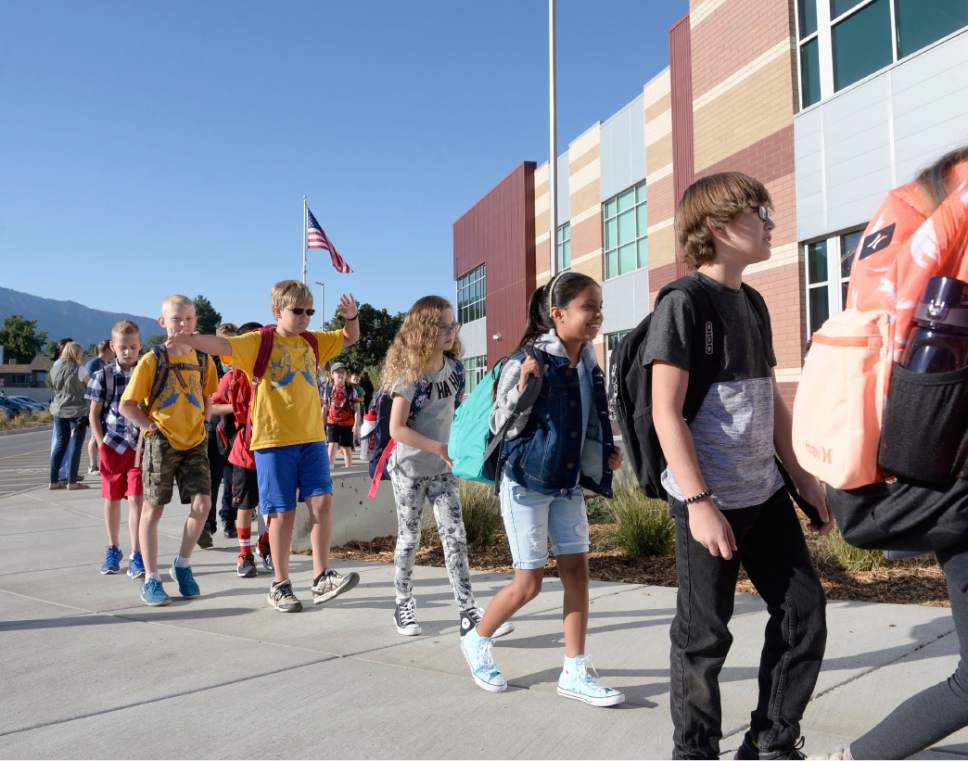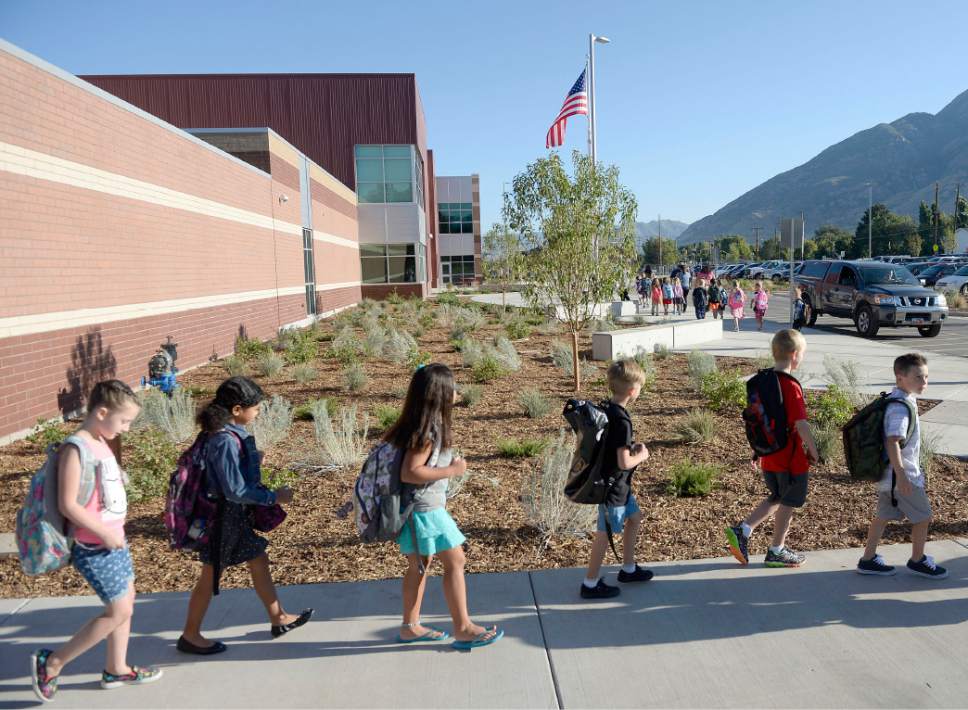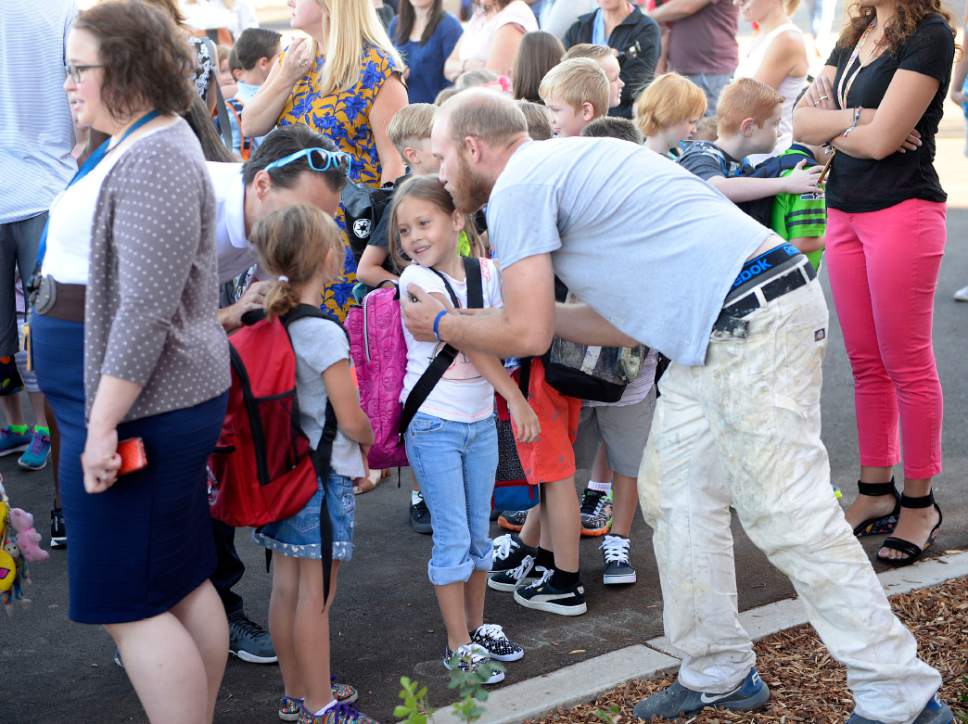This is an archived article that was published on sltrib.com in 2017, and information in the article may be outdated. It is provided only for personal research purposes and may not be reprinted.
Mary Bailey's career in public education can be split nearly in half: 20 years as a teacher and 21 years as an administrator.
That career ended in July, when Bailey retired after three years as the inaugural principal of Draper's Corner Canyon High School.
After more than four decades as an educator, Bailey is quick to respond when asked what can be done to boost student learning.
"You can solve every problem with schools with just one thing, and that's enough good teachers," Bailey said. "The only place that matters in education is the teacher in the classroom — that immediate connection to the kids."
But employing teachers is not one of Utah's strengths.
The state's school districts are currently facing a staffing shortage, with low wages and large class sizes — a product of worst-in-the-nation funding levels — combining to make Utah classroom jobs noncompetitive, and contributing to high turnover rates among school faculty.
That's why Bailey supports Our Schools Now, a proposed ballot initiative that seeks to lift the state's income tax rate from 5 percent to 5.875 percent.
If successful, Our Schools Now would generate roughly $750 million for the state's public education system, including $1.8 million for Corner Canyon High School.
The money, to be distributed on a per-student basis, would mean higher salaries, additional teaching positions, new classroom technology or any other item on the wish lists of administrators and policymakers.
"If we could have more teachers, then we could reduce the stress on the teachers already in the classroom," Bailey said. "There would be more job satisfaction and better retention."
The initiative, expected to reach voters in 2018, is not without its detractors.
Tax-wary advocacy groups bristle at writing schools a $750 million check, while Utah lawmakers object to circumventions of the legislative process.
Critics point to the hundreds of millions of dollars added to school budgets since the Great Recession, which led to incremental and disputed improvements in school performance.
Others, like Sutherland Institute education policy analyst Christine Cooke, cite Utah's above-average graduation rate and best-in-the-nation science scores as evidence that Utah schools are succeeding despite low funding levels.
"More money is not necessarily reform," said Cooke, also a former educator. "Real education reform requires innovations, new ideas, asking big, bold questions and opportunities for personalization."
Lawmakers, who deflated an elections-related ballot initiative in 2014 by passing a compromise bill, plan to hold several hearings on Our Schools Now.
The initiative's organizers, among the most notable and influential business leaders in the state, say they're willing to strike a deal with the Legislature. But they also believe the public is with them, and the initiative won't be satisfied or called off without a significant boost to school coffers.
"We are full steam ahead," said Education First co-chairman Bob Marquardt. "We've gotten quite a bit of attention since our announcement a month ago and a lot of interest."
—
Any which way for pay • When a group of prominent Utahns launched the Count My Vote initiative in 2013 — which would have replaced Utah's caucus and convention system with open primary elections — lawmakers acted quickly to strike a bargain.
The Legislature passed SB54, which allows candidates to bypass the convention system and reach the primary ballot by obtaining signatures.
But Our Schools Now is not Count My Vote, and Logan Republican Sen. Lyle Hillyard anticipates that an income tax hike will have a harder time securing public support.
Utahns talk favorably about funding schools, he said, but that doesn't mean they're willing to increase their own tax burden.
"They're dealing with people voting against themselves," Hillyard said of Our Schools Now, "rather than voting against some group of characters down at the state Capitol building."
Hillyard is the new co-chairman of the Public Education Appropriations Committee, a critical legislative body that oversees school funding.
He said he looks forward to hearing from Our Schools Now supporters. But any action taken by lawmakers during the upcoming session will be based on policy decisions and not a reaction to a taxing campaign.
"The threat of the initiative did not get my attention," Hillyard said. "What got my attention was the quality of the people who support it."
Our Schools Now was launched by Education First, but is led by Scott Anderson, president of Zions Bank; Gail Miller, owner of the Larry H. Miller Group of Cos.; and Ron Jibson, former chairman and CEO of Questar Gas. The campaign's steering committee includes leaders of the Utah Education Association and Utah Parent Teacher Association, members of the Salt Lake Chamber and former authorities of The Church of Jesus Christ of Latter-day Saints.
The initiative raises two complementary but ultimately separate issues, Hillyard said. First is whether and how high to raise the tax rate and second, he said, is the question of how new funding should be spent.
Educators, teachers unions and school advocacy groups typically support funding schools through the weighted pupil unit, or WPU, a per-pupil formula that can be spent at the discretion of local administrators.
But many lawmakers, including Hillyard, prefer targeted funding for priorities like technology, reducing class sizes or increasing entry-level salaries.
"He who spends the money needs to be responsible for raising the taxes," Hillyard said.
The Our Schools Now initiative is still fine-tuning the specifics of its proposal, but Marquardt said new funding would likely be distributed either through or parallel to the WPU, with decision-making preserved at the local level.
"The school will come up with a plan for performance improvement and how they're going to spend the money," he said.
When per-student spending is increased, the bulk of that funding is typically used for teachers, either for salary increases or for health care and retirement costs.
Marquardt said the initiative's organizers are "100 percent" supportive of funding going toward teacher pay, training and retention. But he added that one benefit of a tax increase is that it would provide money for other priorities in addition to compensating educators.
"That is what we want to make sure happens with this initiative," Marquardt said, "that we both focus on compensation, which is a legitimate issue, but also deal significantly with what we're going to do to improve performance."
While he disagrees with the initiative itself, Libertas Institute President Connor Boyack expects lawmakers will respond with their own proposals to boost school funding.
Our Schools Now wants to "shame and badger" the Legislature into acting, he said, and Count My Vote showed that compromise can be the lesser of evils on Capitol Hill.
"I think we'll see another SB54-like bill that will try and find a path in the middle," Boyack said.
Education First's main goal is getting $750 million to schools, Marquardt said, and there are other ways to do that.
Lawmakers could take a "surgical approach," combining a smaller tax increase with a reduction in tax exemptions and taking steps to collect internet sales tax.
"If they could find a better way to bring that additional funding to education," Marquardt said, "we would be fully on board."
Jesselie Anderson, a member of the Utah Board of Regents and co-chairwoman of Education First, was similarly receptive to a legislative solution.
If lawmakers find a way to adequately fund schools, she said, there would be no need to take the issue to voters in 2018.
"We would love for them to take action in January through March and close up shop," Anderson said. "The initiative will keep the pressure on them."
—
'Average isn't good enough' • To qualify for the 2018 ballot, Our Schools Now must gather more than 113,000 signatures, including thousands from at least 26 of Utah's 29 Senate districts.
It's a procedural hurdle that is "nigh unto impossible" for the average citizen displeased with Utah law, according to Boyack. "The wealthy and the elite really are the ones who can control that process."
Our Schools Now is led by the kind of power players who can mount a successful campaign for the ballot, Boyack said. But he quibbles with their messaging that describes the switch from 5 to 5.875 as seven-eighths of 1 percent, when the true tax increase is a 17.5 percent hit to a Utahn's wallet.
"We're talking, for the average family, hundreds of dollars per year from this increase," Boyack said. "If we're going to talk about raising taxes, let's talk about it in a way that makes sense to those being asked to support it."
To many Utahns, Boyack said, school funding is an "untransparent abyss." And he said the initiative's platform is built on a faulty premise — that school performance rises and falls with spending levels.
"Unfortunately, that is a claim without any real basis," he said. "Studies have not been able to prove causation between education funding and education outcomes."
And Cooke, of Sutherland Institute, says advocacy groups paint an overly dire portrait of Utah schools to promote their agenda.
"I do think we are exaggerating the situation at times," Cooke said. "There is a lot of evidence that Utah is doing well in terms of student performance regardless of a low per-pupil spending amount."
Bailey disagrees. She said the reason past investments in education have shown mixed results is because they have been too incremental to make a real impact in schools.
"We have never put enough money in our schools to make a difference," Bailey said, "so how do we know it doesn't work?"
Supporters of the ballot initiative point to Massachusetts, which overhauled its school funding system in the 1990s and is now generally considered the nation's leader for public education.
And Nolan Karras, a former Utah House speaker and co-chairman of Education First, said there are a number of strategies that have proven to help students succeed, but are out of reach.
As an example, Karras points to Granite School District's preschool program, which has demonstrated lasting academic gains among at-risk and low-income students. With additional funding, early-education programs could be expanded throughout Utah, he said.
"You can take a group of disadvantaged kids in this state, pump some money into some pre-K and all-day kindergarten and make a huge difference in their entire life," Karras said, "and a huge difference in the kind of society we're going to live in."
Utah's middle-of-the-pack status might be enough for some, Karras said. But he added that meeting or exceeding the national average is cold comfort when education in the United States, as a whole, is slipping behind most developed and some developing nations.
"The national average isn't good enough to be competitive in the world," Karras said. "It isn't all money, but if you're a system that has the lowest spending in the nation, there's nowhere you can hide from that."
Anderson was optimistic that despite the burden on taxpayers, Utah's residents would be willing to vote for the initiative when the time comes.
"There is a groundswell that is lining up to support this," Anderson said. "They recognize we have got to do something."
Twitter: @bjmanwood



